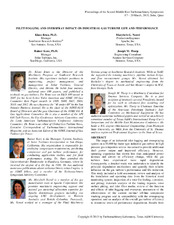| dc.description.abstract | The usage of an industrial inlet fogging and overspraying system on a 35,000 hp frame type industrial gas turbine in high pressure gas reinjection service was aimed to provide additional shaft power output and improved efficiency. However, operating experience has shown less than anticipated power increase and almost no efficiency change, while the gas turbines have experienced more rapid degradation. Consequently, a detailed study was undertaken to identify the principal degradation mechanisms and quantify their relative influence on the gas turbine’s performance and life reduction. This study included a field assessment; review and analysis of the installation and operating data from the historical trend monitoring system; inspection of a rotor for fouling, corrosion, and pitting; materials analysis of the fouling deposits, rotor surface pitting, and inlet filter media; review of the function and effects of inlet fogging and overspray; assessment of the effectiveness of the current on-line/ off-line compressor washing program and its compatibility with the overspraying operation; and an analysis of the overall gas turbine efficiency to determine levels of performance degradation. Results from
Copyright © 2013 by Turbomachinery Laboratory, Texas A&M University
this study identified the principal gas turbine degradation mechanisms, such as blade erosion, corrosion, fouling tip clearance widening, their causes, and their relative influence on the overall performance. For example, the study showed that the total power and efficiency degradation of the unit exceeded ten percent at the time of the rotor overhaul which is well above what is expected for this type of gas turbine. About 70 percent of this degradation was due to blade erosion and rotor clearance widening. These were attributed to the water overspray operation of the gas turbines. Surface fouling and pitting also contributed about 20 percent to the total performance degradation. For the given site conditions, the fogging and overspray system provided a gas turbine performance boost of approximately 2-5 percent in power and less than 0.5 percent in efficiency. Of this performance gain, saturation fogging accounted for about 85 percent, while overspray only provided 15 percent. The principal findings of this study showed that, while the fogging worked, the performance degradation due to water overspray negated most performance gains after only about 24,000 hours of operation. More detailed findings are included in the paper. | en |


